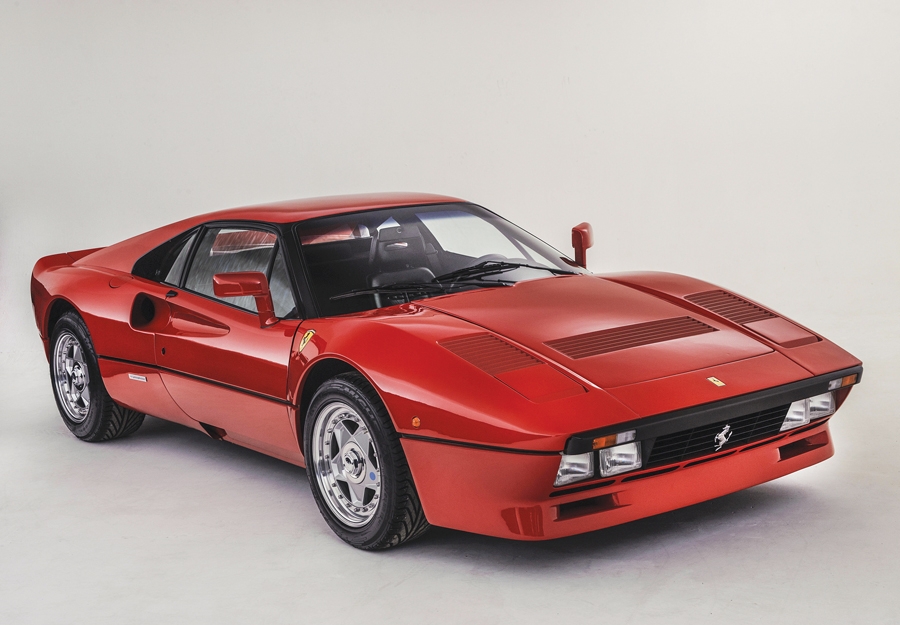SCM Analysis
Detailing
This car, Lot 24, sold for $2,375,584, including buyer’s premium, at Bonhams’ The Bond Street Sale, in London, England, on November 30, 2014.
Put two car guys together long enough and the inevitable question will come up: “What’s your favorite car?” I’ve been asked the question hundreds of times, and after whittling a McLaren F1, various Bugattis, Preston Henn’s 275 GTB/C Special and a Ferrari F40 off the list, the Ferrari 288 GTO is my top dog. Each of the others are strong contenders. Some are better looking and others are much faster, but the 288’s blend of beauty and performance makes it the one car for my garage.
While the 288 GTO is often accused of being a 308 on steroids, I find the accusation complementary and false. Automobile manufacturers qualify cars with the term “new content.” The term defines how much of the old car was used in the new car. When it comes to the 288, almost the entire car is new content.
The silhouette is similar to the 308, but virtually no cosmetic part of the car is interchangeable between the two models. Mechanically, the frame is different, the driveline configuration is different, the transmission is different and the engine — while similar — is different.
A street car designed for competition
Considering all the unique parts were designed, engineered and built for a run of about 200 cars, the very existence of the 288 is quite remarkable. Factor in that the car was designed to compete at the highest levels of serious rallying, and despite the lack of a competition career, the intent was built into the car.
In my eye, the 308 GTB is one of the most beautiful shapes to ever come out of Pininfarina. The bulbous fenders and Kamm tail of the 288 GTO are an asset to the design — and actually functional. The sparse interior of the 288 is purposeful and quite stylish.
The 308 drives nicely but the 288 is in another class altogether. The 400-hp, 2.85-liter V8 is enough to put the GTO in the upper 4-second 0–60 mph range. The 189-mph top speed is great, but it’s the turbos that really make the car fun. The old-school turbos pack the boost in a relatively small rpm range, and when they come on, you need to have the car pointed straight because there’s no traction control to save your butt.
The GTO was designed for top rally drivers, and little was cut back for the production version. You’d better know what you’re doing when you get behind the wheel of a GTO.
Always rare and in demand
288s have always been sought-after cars. They were the first new Ferraris I remember trading at over list price. Most new 288s were pre-sold to good customers of the dealer, but the few that hit the open market sold in the mid-$100k range, which was just about double list price.
Over the next few years, they rapidly gained value to just over $1,000,000 in 1989. For perspective, that was slightly less than a 275 GTB 4-cam and a fifteenth of a 250 GTO.
The 1990 Ferrari market crash hit the 288 hard. Asking prices plummeted all the way to the $250,000 level. When things started getting better, the 288 was again in demand — and prices started to rise.
In the October 2007 SCM (Ferrari Profile, p. 44), I wrote about a 288 GTO that sold for $594k. I incorrectly thought that price was very optimistic. During that period, a 246 GT was a $140,000 car, a 330 GTC was under $200,000 and 275 GTB/4s had recently broken the million-dollar mark.
A non-scientific comparison puts current Dino values up about 2.5 times from 2007, and 330 GTC prices are up about 4.4 times. Lussos are up 4.5 times, and 275 GTB/4s are up about three times.
With respect to the 4-cam cars, the numbers are a bit misleading, as they were early bloomers.
A big hit
At $2,369,802, Bonhams hit the ball out of the park with this 288 GTO sale. The number was more than $500k over the last auction sale. In perspective, though, it was a 3.8 multiple over 2007, which is well in line with many other Ferraris.
While we’re crunching numbers, Bonhams’ 288 sale was about one-sixteenth of their 250 GTO sale at Quail Lodge during the 2014 Monterey Car Week. This is about the same as 1990 ratios. However, compared with the 275 GTB/4, the 288 still has some catching up to do.
More 288s lured out of garages
A quick survey of the market shows the high values have brought some 288s out of the garages. An unprecedented five 288 GTOs are actively on the market. RM is offering a 6,500-mile car at their 2015 Scottsdale sale. Their estimate is $1,900,000 to $2,400,000.
A 2,500-mile example is being privately offered in the $2.5m range. An ex-Keke Rosberg car is available in California. A 19,000-mile 288 is for sale at a Northeast Ferrari dealer, and an ex-Bill Cosby GTO is for sale in Dubai. The last three are not advertised with prices, but be assured none are cheap.
A complete supercar collection is the goal of many Ferrari collectors, and the 288 is the rarest card in the pack. As long as the market is thriving, the 288 will be in demand, but finding five buyers looking for $2 million-plus 288s right now may be optimistic — even in today’s craziness. ♦
(Introductory descriptions courtesy of Bonhams.)
